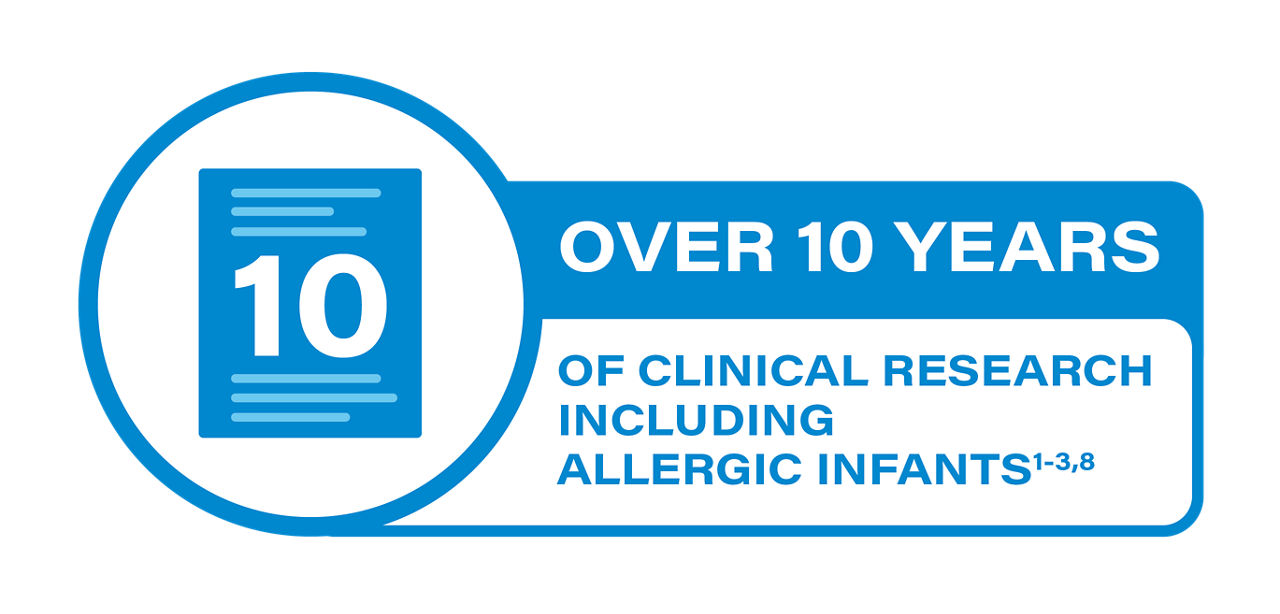Myth 1 - Cow’s Milk Allergy is the same as lactose intolerance
This is incorrect.
Cow’s Milk Allergy (CMA), also referred to as Cow’s Milk Protein Allergy (CMPA), involves the immune system and is a reaction to the protein within the milk. Frequently, there is confusion between CMA and lactose intolerance.
In contrast to CMA, lactose intolerance does not involve the immune system and is caused by a lack of the enzyme Lactase which leads to the malabsorption of Lactose (sugar in milk)1. CMA is more common in young infants whereas lactose intolerance is usually associated with older children or adults2.
Myth 2 - Allergic reactions to food always appear very quickly after eating or drinking a food
This is incorrect.
Food allergies cause an adverse immune response to a trigger food. These food allergies can be classified as either IgE mediated allergy or Non-IgE mediated allergy. Although usually an individual is diagnosed with either IgE or Non-IgE mediated allergies, some individuals may have a mixed allergy3.
IgE mediated food allergy reactions are acute allergic reactions where symptoms typically appear ‘immediately’ within seconds up to two hours after the problem food is ingested.
Non-Ige mediated food allergies usually present as a ‘delayed’ allergic reaction (2-72hrs) after ingestion of the allergen.
Each of these reactions are classed as allergies as they both involve the immune system, but symptoms and diagnosis differ3.
Myth 3 - Blood test for Cow's Milk Allergy is the best diagnostic instrument
This is incorrect.
Specific IgE (SIgE) blood tests are used by clinicians to help determine how likely it is that an individual has an IgE mediated allergy to a specific food. These blood tests should not be confused with IgG testing which are widely available on the internet but do not have any scientific validity to support a diagnosis of a food allergy.
SIgE blood tests should not be used in isolation and must be interpreted by a specialist allergy clinician alongside skin prick test (SPT) and a clear allergy-focused history4. ‘False positive’ results to SIgE and SPT are possible5. SPT and SIgE bloods are only used to diagnose IgE mediated allergies not those with non-IgE mediated allergies. Non-IgE allergies are diagnosed by an elimination followed by a challenge with the suspected allergen.
A food challenge or supervised feed is a more definitive approach to determine if a patient has a food allergy. For those with suspected non-IgE mediated allergies these challenges can usually take place at home, however, for patients with a suspected IgE mediated allergies or more severe non-IgE mediated allergies (including FPIES), this will usually take place in hospital with medical supervision as a precaution6.
Positive test results do not give us a simple yes or no answer to whether an individual is going to have a reaction, nor does it tell us how severe the reaction is going to be; however, they do give us an indication of how likely it is they will have an allergic reaction7.
Myth 4 - Eczema is a sign of a Cow’s Milk Allergy
This is correct.
Eczema can be one of the signs that infants with CMA experience. However, not every infant with CMA will have eczema and not every infant with eczema will have CMA.
Children with an atopic history such as early infantile eczema (before 6 months of age) or an existing food allergy have an increased risk of developing further food allergies8.
Myth 5 - Goat’s milk infant formula is a good replacement for when a baby is allergic to Cow’s milk
This is incorrect.
Goat’s milk formulas are not a suitable alternative for infants with CMA. This is because the protein in goat’s milk is very similar to those in cow’s milk, therefore, the infant is likely to react - this is the case for all mammalian milks including sheep, camel and buffalo8.
Breastfeeding is first line advice for all infants. If they are reacting to breast milk a maternal dietary exclusion would be recommended. For those formula fed infants, around 90% with CMA will be able to tolerate an extensively hydrolysed formula (EHF), and therefore they should be prescribed first line. EHFs have been broken down to small protein molecules and therefore are less likely to cause an immune response. For the remaining small percentage of children, amino acid formula (AAF) may be more suitable. These formulas are made up of individual amino acids and should only be used in severe presentations of CMA such as anaphylaxis or if individuals have not tolerated an EHF9.
Myth 6 - The intensity of the previous reaction to the allergen predicts future reactions
This is incorrect.
Food allergy reactions can be very unpredictable. Dose of the allergen is considered to have the greatest impact, with large doses associated with more severe reactions10. The individual’s symptoms may also vary after ingestion; they may have hives with one reaction but vomiting with a subsequent reaction. A recent study found the severity of milk allergy reactions were more predictable than the severity of peanut reactions11.
Due to the unpredictable nature of allergies, it is very important that parents and children know how to manage their allergy if they have a reaction by following their allergy plan, put in place by a health care professional.
Myth 7 - Cow’s Milk Allergy is genetic
This is in part correct.
A family history of atopy or food allergies in either a parent or a sibling has also been found to increase the risk factors of an infant developing a food allergy12.
To reduce the risk of food allergies in high-risk infants, recent evidence has suggested beneficial effects of early introduction of common allergens. The ‘Learning Early About Peanut’ (LEAP) study13 introduced peanuts into the diet of high-risk infants with significant eczema or pre-existing egg allergy aged 4-10 months, and found early introduction significantly reduced the risk of peanut allergies in these high-risk infants.
As a result of this evidence, the BSACI (British Society for Allergy and Clinical Immunology) have developed guidance for early introduction of allergens in high-risk infants14.
Myth 8 – Cow’s Milk Allergy is not dangerous
This is incorrect.
The general public usually associate severe/dangerous reactions with peanut allergies, however, a recent study found that in the UK 19% of anaphylaxis food allergy reactions are triggered by a peanut allergy, but 12% of cases of anaphylaxis were associated with a Cow’s Milk Allergy.
Anaphylaxis is diagnosed when two or more of these symptoms occur:
- Involvement of the skin or mucosal tissue
- respiratory compromise
- cardiovascular compromise
- persistent gastrointestinal symptoms and hypotension
In extreme cases, these symptoms can lead to death15.
Myth 9 – All food allergies in children resolve as they get older
This is incorrect.
Outgrowing a food allergy depends on several factors. Studies showed that children with a milk allergy have a 50-60% chance of outgrowing their allergy by the age of 2 and 79% by the age of 16 years16. Children with egg allergies show a slower rate of achieving tolerance, but 68% will achieve tolerance by 16 years of age17.
Those individuals with a peanut allergy, however, are less likely to outgrow their allergy with only a 20% probability of outgrowth18.
- Deng Y, et al. Lactose Intolerance in Adults: Biological Mechanism and Dietary Management. Nutrients. 2015;7(9):8020-35
- Luyt D, et al. Standards of Care Committee (SOCC) of the British Society for Allergy and Clinical Immunology (BSACI). BSACI guideline for the diagnosis and management of cow's milk allergy. Clin Exp Allergy. 2014;44(5):642-72
- National Institute for Health and Clinical Excellence (2011) Food allergy in children and young people (Guideline 116). [internet] [cited 2023 Jan 14]. Available from: Food allergy in children and young people (nice.org.uk)
- National Institute for Health and Clinical Excellence, (2016) Food Allergy Quality Standard (QS118). [internet] [cited 2023 Jan 14]. Available from: Quality statement 1: Allergy‑focused clinical history | Food allergy | Quality standards | NICE
- Heinzerling L, et al. The skin prick test – European standards. Clin Transl Allergy.2013; 3(1). [internet] [cited 2023 Jan 14]. Available from: https://doi.org/10.1186/2045-7022-3-3
- Oral Food Challenge | Allergy UK | National Charity [cited 2023 Jan 14].
- Ansotegui IJ, et al. IgE allergy diagnostics and other relevant tests in allergy, a World Allergy Organization position paper. World Allergy Organ J. 2020 Feb 25;13(2):100080. doi: 10.1016/j.waojou.2019.100080. Erratum in: World Allergy Organ J. 2021;14(7):100557.
- National Institute for Health and Clinical Excellence (2015). Cow’s milk protein allergy in children, clinical knowledge summary. [internet] [cited 2023 Jan 14]. Available from: https://cks.nice.org.uk/cows-milk-protein-allergy-in-children
- Quality standard for food allergy QS118 (2016). [internet] [cited 2023 Jan 14]. Available from: http://www.nice.org.uk/guidance/qs118
- Ballmer-Weber BK, et al. How much is too much? Threshold dose distributions for 5 food allergens. J Allergy Clin Immunol. 2015;135(4):964-971.
- Pettersson ME, et al. Prediction of the severity of allergic reactions to foods. Allergy. 2018;73(7):1532-1540.
- Flom JD, et al. Epidemiology of Cow's Milk Allergy. Nutrients. 2019; 11(5) :1051.
- Du Toit G, et al. LEAP Study Team. Randomized trial of peanut consumption in infants at risk for peanut allergy. N Engl J Med. 2015; 372 (9): 803 – 13.
- BSACI Early Feeding Guidance. 2018 [internet] [cited 2023 Jan 14]. Available from: https://www.bsaci.org/professional-resources/resources/early-feeding-guidelines/
- Cianferoni A, et al. Food-induced anaphylaxis. Immunol Allergy Clin North Am. 2012;32(1):165-95.
- Fernández-Rivas M, et al. The EuroPrevall outpatient clinic study on food allergy: background and methodology. Allergy. 2015;70(5):576-84.
- Savage JH, et al. The natural history of egg allergy. J Allergy Clin Immunol. 2007;120(6):1413-7.
- Venter C, et al. The prevalence, natural history and time trends of peanut allergy over the first 10 years of life in two cohorts born in the same geographical location 12 years apart. Pediatr Allergy Immunol. 2016;27(8):804-811.
Help us provide information most relevant to you
Please ensure your role and areas of interest are up to date.





